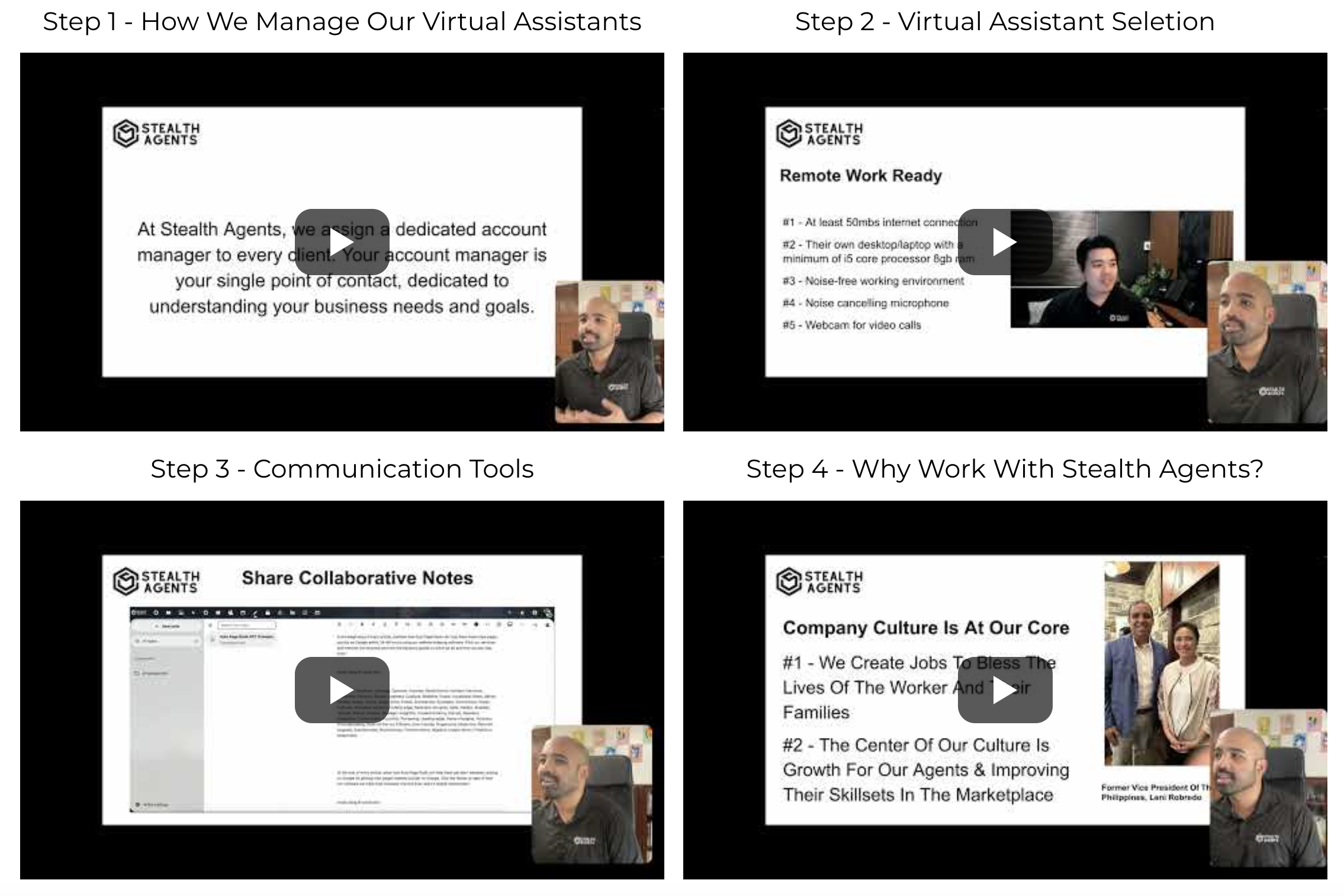Choosing the right tools can significantly impact team productivity and communication. Slack and Teamwork are popular platforms, each catering to distinct aspects of project management and communication.
Slack is renowned for its real-time messaging capabilities. It fosters seamless communication with chat rooms, direct messaging, and integrations with numerous apps, making it ideal for teams that prioritize instant communication and agile workflows.
On the other hand, Teamwork excels in project management, offering robust features for task tracking, time management software, and resource allocation, providing a comprehensive solution for teams focused on detailed project planning and execution.
The choice between Slack and Teamwork ultimately depends on whether a team needs more of a communication hub or detailed best project management software.
Stealth Agents carefully created and curated this resource to help you make an informed decision tailored to your team’s specific collaboration needs.
What is Slack?
Slack is a powerful platform for enhancing team collaboration and streamlining workplace communication.
It allows teams to communicate in channels organized by project, topic, or team, ensuring that conversations are easily accessible and well-organized.
With its real-time messaging capabilities, Slack provides a space for instant communication, file sharing, and integration with various third-party tools, making it a versatile solution for businesses of all sizes.
Its user-friendly interface and extensive customization options enable teams to tailor the platform to their needs, fostering a more connected and efficient working environment.
Slack plays a crucial role in enhancing productivity and collaboration within organizations by centralizing communication and facilitating seamless interaction.
Key Features:
-
Channels: Slack organizes conversations into channels based on topics, teams, or projects, enabling users to keep discussions focused and relevant. This structure helps in reducing email clutter and ensures that important information is accessible to all relevant team members.
-
Direct Messaging: Users can send private messages to individuals or small groups for more focused discussions. This feature allows for quick and confidential communication, which is ideal forideal for promptlyive issues or coordinating tasks promptly.
-
File Sh Storage: Slack allows users to share files directly within the chat interface, supporting various file types. This capability makes it easier for teams to collaborate on documents and keep all related materials in one place.
-
Integration with Other Apps: Slack integrates wTo enhance its functionality, ith numerous third-party applications, such as Google Drive, Trello, and Zoom, to enhance its f supports a seamless workflow, where users can perform various tasks without leaving the Slack environment.
-
Searchable History: Slack maintains a searchable archive of all messages and files, making it easy to retrievretrievings and documents. This feature is easyparticularly useful for keeping track of decisions made and ensuring nothing important slips through the cracks.
Pros:
-
Enhanced Communication: Slack’s real-time messaging helps reduce email overload and facilitates instant communication. Teams can quickly exchange ideas and updates, improving overall efficiency and connectivity.
-
Customization and Flexibility: With its customizable settings and wide range of app integrations, Slack can be tailored to fit the unique needs of diverse teams. This adaptability makes it suitable for various industries and work styles.
-
Improved Collaboration: By providing a central hub for communication and file sharing, Slack encourages collaboration and transparency. Teams can work together more effectively, with all necessary information at their fingertips.
-
Intuitive User Interface: Slack’s user-friendly design makes it easy for newcomers to get up to speed quickly. The platform’s intuitive navigation and clear organization contribute to a positive user experience.
-
Remote Work Support: Slack is particularly beneficial for remote teams, offering tools that facilitate virtual assistant collaboration. Features like video calls and screen sharing help maintain strong team connections despite physical distances.
Cons:
-
Information Overload: With so many channels and messages, users may find it challenging to keep up with everything. Important messages can get lost in the flow of communication, particularly in larger teams.
-
Dependency on Internet Connection: Slack’s functionality relies heavily on a stable internet connection. Connectivity issues can disrupt communication and hinder workflow, particularly for remote teams in areas with poor internet service.
-
Learning Curve for New Users: While Slack is generally intuitive, new users may need time to adapt to its features and workflow. Training or onboarding sessions might be necessary to ensure all team members can use Slack effectively.
-
Notification Management: The constant stream of notifications can be overwhelming for some users, leading to distraction and interrupted workflow. Users must be proactive in managing their notification settings to maintain focus.
-
Cost for Premium Features: While Slack offers a free version, many of its advanced features are only available with paid plans. Smaller teams or startups might find the subscription costs prohibitive as they scale.
What is Teamwork?
Teamwork is a comprehensive project management platform designed to help teams organize tasks, track progress, and collaborate effectively.
It provides a structured environment where teams can plan projects, assign tasks, and monitor deadlines, ensuring that all aspects of a project are well-coordinated.
The platform facilitates seamless communication and collaboration through its shared workspace, allowing team members to discuss tasks and share updates in real-time.
With its user-friendly interface, Teamwork simplifies project management for businesses of any size, making it easy to manage complex workflows.
Teamwork enhances organizational productivity and accountability by centralizing project information and providing robust top task management tools.
Key Features:
-
Task Management: Teamwork allows users to create, assign, and prioritize tasks, making it easier to manage workloads and ensure deadlines are met. This feature helps teams stay organized and maintain focus on critical project components.
-
Time Tracking: Built-in time tracking tools enable teams to log work hours, providing insights into productivity and resource allocation. This function is valuable for billing clients accurately and assessing project efficiency.
-
Gantt Charts: Teamwork offers Gantt charts for visual project planning, allowing users to map out tasks and timelines. This feature helps in identifying project dependencies and potential bottlenecks, ensuring smoother project execution.
-
Document Management: Users can store and share documents within Teamwork, centralizing all project-related files. This capability facilitates easy access to important documents and supports collaborative editing and feedback.
-
Communication Tools: Teamwork includes messaging and comment features that promote real-time communication among team members. This integration reduces the need for external communication tools and keeps all project discussions in one place.
Pros:
-
Comprehensive Project Overview: Teamwork provides a detailed view of project progress, allowing managers to assess the status and make informed decisions quickly. This overview helps maintain project timelines and meet client expectations.
-
User-Friendly Interface: The platform’s intuitive design and easy navigation make it accessible at all levels. New team members can quickly learn to use digital tools for startups, reducing the time needed for onboarding and training.
-
Collaboration Enhancement: By centralizing communication and project management, Teamwork fosters a collaborative environment where team members can easily share insights and updates. This connectivity improves teamwork and project outcomes.
-
Scalability: Teamwork offers flexible plans and features that grow with your business, accommodating the needs of both small teams and large organizations. This scalability makes it a sustainable option for companies planning for future growth.
-
Client Access: Teamwork allows clients to access projects directly, promoting transparency and building trust. This feature enables clients to provide feedback and stay informed about project progress without constant updates from the team.
Cons:
-
Complexity for Small Projects: While Teamwork is feature-rich, its extensive tools may overwhelm small teams or simple projects. Users might find themselves navigating unnecessary features that complicate the workflow.
-
Learning Curve: Despite its user-friendly interface, the breadth of features can be daunting for new users. Teams may require time and training to leverage all the capabilities offered by Teamwork fully.
-
Cost Considerations: Teamwork’s robust features come at a higher price point compared to simpler project management tools. Smaller businesses may find the subscription costs challenging, especially when scaling up.
-
Integration Limitations: Although Teamwork integrates with various applications, users might encounter limitations or require additional tools for comprehensive workflows. This can lead to extra expenses or complexity in managing integrations.
-
Overdependence on Features: Relying heavily on Teamwork’s features may lead to over-complicating project management processes. Teams must balance digital tools with effective communication and traditional project management practices.
Slack vs Teamwork: Detailed Features Comparison
1. Communication Capabilities
In the Slack vs Teamwork debate, Slack takes the lead with its robust communication features.
It excels in real-time messaging, allowing team members to interact instantly through channels and direct messages, which topics or projects can organize.
Slack’s integration with various third-party apps like Google Calendar and Zoom further enhances its communication capabilities, making it a preferred choice for teams that prioritize seamless interaction.
On the other hand, Teamwork focuses on integrating communication within project management by offering messaging and comment features directly linked to tasks and projects.
While Teamwork provides adequate communication tools, Slack’s primary focus on instant messaging and app integrations gives it a significant edge in facilitating dynamic and ongoing discussions.
2. Project Management and Organization
When it comes to Slack vs Teamwork, Teamwork is specifically designed to handle complex project management needs.
It provides comprehensive tools like task assignment, Gantt charts, and time tracking to ensure projects are well-organized and deadlines are met.
Teamwork excels in visual best project planning software, allowing users to effectively map out tasks, timelines, and dependencies.
While Slack is not primarily a project management tool, it does offer integrations with project management apps like Trello and Asana, allowing users to manage tasks within the Slack interface.
However, for teams that need an all-in-one solution for both communication and detailed project management, Teamwork offers more robust in-built tools compared to Slack’s reliance on external app integrations.
3. File Sharing and Document Management
In the Slack vs Teamwork comparison, both platforms offer file-sharing capabilities, but their focus differs.
Slack allows users to share files directly within chats, supporting various file types and enabling quick collaboration on documents.
Its searchable archive ensures that past files are easily retrievable, making it a convenient tool for ongoing projects.
Teamwork, however, places greater emphasis on document management by providing a centralized repository for project-related files, facilitating easy access and collaborative editing.
This feature is particularly beneficial for teams that require structured document storage within their project management workflow, offering a more organized approach than Slack’s chat-based file sharing.
4. Integration with Third-Party Applications
Slack vs Teamwork reveals distinct strategies in enhancing functionality through integrations.
Slack is renowned for its extensive integration options, connecting seamlessly with over 2,000 apps, which allows users to customize their workflow and enhance productivity without leaving the Slack environment.
This flexibility is ideal for teams that utilize a range of tools and need a central hub for communication and task management.
Teamwork, while offering integrations, focuses more on providing comprehensive built-in features for project management, reducing the need for numerous external apps.
For teams seeking a wide array of integrations to complement their existing tools, Slack provides a more versatile solution than Teamwork.
5. User Experience and Interface
In the Slack vs Teamwork analysis, user experience is a critical factor that influences platform preference.
Slack is praised for its intuitive and user-friendly interface, making it easy for teams to navigate and get started quickly. Its design caters to enhancing user engagement through simple navigation and customization options.
Teamwork, although also user-friendly, presents a more complex interface due to its extensive project management features, which might require a steeper learning curve for new users.
However, for those who prioritize detailed project management capabilities alongside communication, Teamwork offers a comprehensive user experience tailored to managing workflows efficiently.
How Stealth Agents Choose Slack vs Teamwork?
When Stealth Agents choose between Slack vs Teamwork, they carefully evaluate several key factors to determine the best fit for their needs.
They consider the team’s size and dynamics, recognizing that larger teams with extensive communication needs might benefit more from Slack’s robust messaging capabilities.
For projects requiring detailed planning and execution, Teamwork’s comprehensive project management tools, such as Gantt charts and task tracking, can be more advantageous.
The complexity of the project also plays a crucial role; complex projects might demand Teamwork’s structured organization, whereas Slack could efficiently handle straightforward communication needs.
Integration requirements are another critical aspect, as Slack’s extensive app integrations provide flexibility for teams using multiple external tools.
Stealth Agents also assess the need for real-time collaboration, with Slack offering a more immediate communication solution and Teamwork providing a cohesive project-focused environment.
By weighing these considerations, Stealth Agents can make an informed decision, ensuring that the chosen platform aligns with their workflow and enhances overall team productivity.
If you are also looking for a virtual assistant, Stealth Agents stands ready to assist. You can book a free discussion to tailor preferences and explore virtual assistant pricing options.
Conclusion
When deciding between Slack vs Teamwork, it’s essential to consider your team’s specific needs and dynamics.
Slack facilitates seamless communication and integrates well with various external applications, making it ideal for teams focused on real-time interaction and flexible workflows.
On the other hand, Teamwork stands out with its comprehensive project management features, offering a structured environment for planning and executing complex projects.
Both platforms have unique strengths, and the choice ultimately depends on whether your team prioritizes communication or detailed project management.
By understanding the distinct benefits of each, teams can select the tool that best supports their collaboration and productivity goals.












